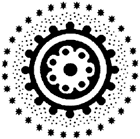 Clicking
on an image will open another window. You can use the second window
to scroll through all the enlarged images associated with this article
Clicking
on an image will open another window. You can use the second window
to scroll through all the enlarged images associated with this article |
The Henna Page Journal |
|
The midwife attending the birth in North Africa took care to assure the woman that malicious supernatural spirits were dispelled. This was accomplished with henna, incense, amulets, and ritual actions. In Moroccan Jewish households, a magic circle was drawn in the air around the laboring woman with a large sword to deter evil spirits. At the moment of birth in Amazigh Morocco, the mother was kept covered, with only the midwife can attending her, so the “evil eye” could not catch sight of her genital organs and cause her harm (Legey, 1926: 124). A laboring woman was therefore in a secure and familiar place, undistracted, accompanied only by one trusted helper. Several strangers peering between her legs, bright lights, and machines surround a woman in a western obstetric ward. These are helpful in insuring hygiene, medical expertise, and optimize chances for a healthy delivery, but can be unsettling to the mother if she is not familiar with western medical practice.
The child’s umbilical cord was dabbed with henna, and was disposed of through ritual action in most North African and Middle Eastern groups. When an Ait Yusi child’s umbilical cord fell off, it was buried under the household’s roof-pole, with barley, salt and henna, to protect the child from jealous spirits. The knife used to cut the umbilical cord was first put under the child’s head to protect it from malicious spirits, and then was used to cut the meat of a sheep or goat sacrificed on the seventh day after birth. Among the Hiana, the cord and swaddling clothes were buried or thrown into a river, along with the knife that cut the cord, lest an enemy find these things and practice magic with them. In Andjra, the midwife daubed henna on the umbilical cord and buried it with the afterbirth at a local saint’s shrine to insure supernatural protection (Westermarck 1926, II, 372-3). Western obstetrical practice may conserve the placenta and umbilical cord for research purposes. The birthing surgical instruments and linens are be autoclaved and reused, or if disposable, will be incinerated or sent to a landfill. If a woman believes that strangers or spirits may access these and thus deliberately or accidentally harm her and her child, her anxiety may contribute to postnatal depression. |
|
|
|||
| [Home] [How] [Why] [What] [Where] [FAQ] [Forum] | |||

